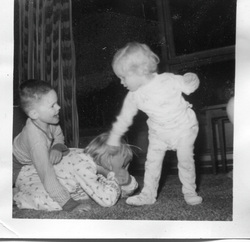If knowing your own opinion and your own feelings about issues is the place to start writing to change the world--the second step is finding out more. Lots of times, we think that the big issues are far away from us--like the war--or far in the past, like the discrimination against people of color and the civil rights movement. A writer who wants to change the world NOTICES what is happening--by paying attention. The local newspaper, the local radio stations and television stations, and internet news sites for children are all good places to learn about what is going on--and so is talking with your family, your teachers, and your friends. We discover that while the war might be far away in physical distance, its impact is felt right here in the mountains. We wish that racial discrimination was in our past, but we discover that it's not. These are just two issues of concern--what else might you find?
Assignment:
This week, pay attention and notice. Choose an issue that concerns you and write a reflection on your blog. A reflection is simply a statement about how you feel and what you think about the issue and WHY. You might choose an issue we've discussed in class, or you might choose an issue that you read about in the local paper or heard about on the news. The reflection should be at least one paragraph.
Racial Slurs yelled at Local Residents
What is the story behind this photograph? What questions can you ask to help me dig deep? Look closely, notice EVERYTHING! Try to ask one small potato question and one big potato question. Next week, I'll share the answers and the story with you!
Then, work with a partner and help them to dig deeper into their photograph descriptions--help him or her to find the story.
Thumbs up! Ms. Kyles class divided into small groups and were given the instruction to arrange themselves by their thumbs. What? Yep. By their thumbs. After a few minutes to talk and come to an agreement about how they would do this, the students presented their "arrangement" by group. A couple lined up according to length of thumb, one group divided into two because half their group had thumbs which curved at the end, while the others were straight. Another group looked at the lines on the top of their thumbs and still another considered the color of their nails.
The students then sat down to talk about the process and make some observations about what it takes to have a successful group process.
1. Each person gets to talk.
2. Make sure everyone is invited to speak--invited SINCERELY.
3. Listen to everyone's ideas and include in discussion.
4. Explore ideas by looking at birthdays and seasons.
(The class came up with these words to replace the traditional pros and cons. The offered words that had positive meanings and words represented change, rather than "bad." After a vote, the group chose birthdays and seasons.)
We'll continue to explore community agreements.
The students were then asked to examine their thumbs closely, from all angles, and do a quick sketch. A good writer takes notice very ACTIVELY. Lots of times, we assume we know something well, even something so close to us as our thumbs. The students looked at their thumbs and used their other senses as well. Even tasting!
Assignment: Pretend your thumb can speak. What story would it tell about you and what voice would it use to tell the story. Write a paragraph ( or more).

 RSS Feed
RSS Feed